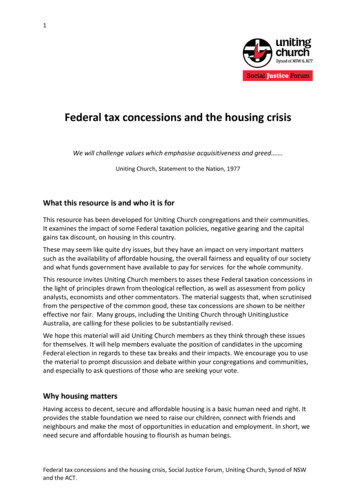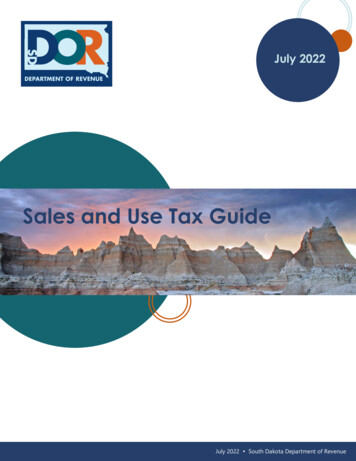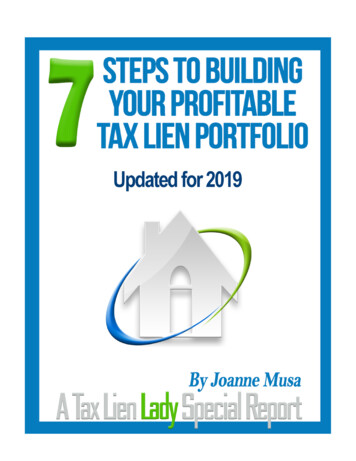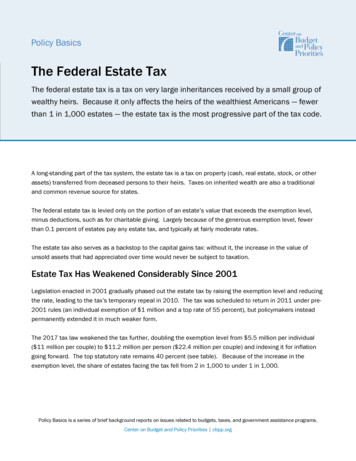
Transcription
1Federal tax concessions and the housing crisisWe will challenge values which emphasise acquisitiveness and greed .Uniting Church, Statement to the Nation, 1977What this resource is and who it is forThis resource has been developed for Uniting Church congregations and their communities.It examines the impact of some Federal taxation policies, negative gearing and the capitalgains tax discount, on housing in this country.These may seem like quite dry issues, but they have an impact on very important matterssuch as the availability of affordable housing, the overall fairness and equality of our societyand what funds government have available to pay for services for the whole community.This resource invites Uniting Church members to asses these Federal taxation concessions inthe light of principles drawn from theological reflection, as well as assessment from policyanalysts, economists and other commentators. The material suggests that, when scrutinisedfrom the perspective of the common good, these tax concessions are shown to be neithereffective nor fair. Many groups, including the Uniting Church through UnitingJusticeAustralia, are calling for these policies to be substantially revised.We hope this material will aid Uniting Church members as they think through these issuesfor themselves. It will help members evaluate the position of candidates in the upcomingFederal election in regards to these tax breaks and their impacts. We encourage you to usethe material to prompt discussion and debate within your congregations and communities,and especially to ask questions of those who are seeking your vote.Why housing mattersHaving access to decent, secure and affordable housing is a basic human need and right. Itprovides the stable foundation we need to raise our children, connect with friends andneighbours and make the most of opportunities in education and employment. In short, weneed secure and affordable housing to flourish as human beings.Federal tax concessions and the housing crisis, Social Justice Forum, Uniting Church, Synod of NSWand the ACT.
2Currently Australia is experiencing a crisis in secure and affordable housing: Home ownership: Rising prices means owning your own home is becoming moredifficult. Younger people and those on lower and middle incomes are being squeezedout of home ownership. 1-3 Private rental: More people are renting than ever before, including more familieswith children. Nationally, there is a shortage of 539,000 rental properties for lowincome households.4,5 While pressures are greatest in capital cities, housing stressextends to all areas.Difficulties in housing are even more acute for those on waiting lists for social andaffordable housing and for the more than 100,000 people experiencing homelessness in anygiven year.6Many factors impact on housingHousing is a complex area. There are many factors that impact on both the supply of, anddemand for housing. Some areas, such as zoning laws and release of land are theresponsibility of state and local governments; some are more the concern of our Federalgovernment. Both negative gearing and the capital gains tax discount are Federal taxconcessions. While many factors influence the availability and affordability of housing,commentators agree these concessions have a significant impact on demand for housingand the price of housing. It makes sense, in a Federal election year, to examine thesepolicies and their effects and consider if they need changing.Values and principles that inform a Christian view of taxationAt its inauguration in 1977 the Uniting Church included this statement:We will challenge values which emphasise acquisitiveness and greed in disregard of theneeds of others and which encourage a higher standard of living for the privileged in the faceof the daily widening gap between rich and poor.In its thinking about taxation the Uniting Church, through the work of UnitingJusticeAustralia and other parties, has identified a number of principles that shape a Christian viewof wealth and taxation: 7,8 The world and the abundance it provides is God’s generous gift for the wellbeing ofall. As recipients of this gift, human beings have a responsibility to ensure that allhave a share in the wealth it provides.In a democracy such as Australia, taxation provides a primary tool for the equitabledistribution of wealth and the provision of resources for the common good.The design of our taxation system determines the ability of our governments to fulfiltheir responsibility to provide services so that all people may have a decent life andthe opportunity to share in the wellbeing of the community.As Christians we must respond particularly to God’s call to care for the mostvulnerable in our society, and taxation is one means by which resources are providedfor this care.Federal tax concessions and the housing crisis, Social Justice Forum, Uniting Church, Synod of NSWand the ACT.
3 When people are debating taxation they are actually talking about the level ofresponsibility we accept for each other.Taxation should not be seen primarily as a burden to be endured, but as anappropriate response to God’s generous provision to us.In line with these principles a taxation system should generally be:7 Progressive: People should contribute according to their means. Those with moreshould contribute a greater proportion than those with less.Equitable: There will be inequalities in income across different groups and acrossgenerations, but gross inequality undermines community wellbeing and isinconsistent with the biblical vision. It is one role of the taxation system to reducethese inequalities and enable a fairer sharing of resources.Redistributive: In addition to providing services for all, such as health, transport andeducation, taxation should assist those who are most vulnerable and in need ofsupport to have a decent life.The Uniting Church believes that the taxation system is our primary means for ensuring theequitable distribution of wealth and the raising of public money, our ‘common wealth’, inorder that we may ensure that the basic needs of people in society are met.8Negative gearing and capital gains tax discount – how do they work?Negative gearingNegative gearing allows investors to deduct the cost of an investment property against alltheir other income, thus lowering their tax bill.Negative gearing was originally introduced in the 1980s to stimulate the building of newdwellings, with the aim of boosting the economy and increasing the supply of housing at thesame time.Negative gearing allows tax payers to subtract losses they make on investments from theirtaxable wage income. It works in the following way. An investor borrows money to buy aresidential property and rents it out. If the rent they receive is less than the money theyspend on the property, including interest on loan repayments, then this loss can bededucted from their other taxable income. Australia is one of only three OECD nations(Japan and New Zealand are the others) that allows this kind of deduction. There is no limiton the deductions that can be claimed for investment expenses from rental properties.It’s important to remember that although the investor may be making a loss in terms of rentreceived, the property is increasing in value. When they sell the property they expect (orhope) it will be worth more than when it was purchased. This increased value is called thecapital gain. When housing prices increase rapidly investors can make very substantialcapital gains.Federal tax concessions and the housing crisis, Social Justice Forum, Uniting Church, Synod of NSWand the ACT.
4Capital gains tax discountThe capital gains tax discount (CGT discount) means investors only pay tax on half theincreased price when a property is sold. (Note: owner occupiers pay no capital gains tax)Capital gains are subject to capital gains tax (CGT). This tax is paid when an asset is sold formore than it cost. In 1999 the Australian government introduced a 50% discount on theCGT, if you have held the asset for more than one year. This means only half the capital gainon an investment property is subject to tax. For example, if a property was purchased for 500, 000 and sold for 700, 000 the capital gain is 200, 000. But the owner would only paytax on one half, or 100,000, of the capital gain.It is the combination of a capital gains tax discount, together with negative gearing, that hasso encouraged speculative investment in the property market in Australia.What are costs of these tax breaks?Work by the Australia Institute estimates the cost of both tax concessions is about 7.7billion a year.1 This is made up of 3.7 billion for negative gearing and 4 billion for capitalgains tax discount. Both these concessions represent a loss of taxation revenue for thecommunity as a whole.Other groups have made estimates of the cost of these tax concessions. For example,estimates on the cost of negative gearing ranged from 2.4 to 4.6 billion. While estimatesvary, there is agreement they represent a very significant amount of forgone income.9-12Moody’s analysts Glenn Levine and Fred Gibson say economists have criticised negativegearing as an unfair and unproductive distortion that cost the Federal Government around 4 billion a year.9Who benefits from these tax breaks?Around 1.2 million Australians use negative gearing to invest in residential property. Aproportion of these are on modest incomes. Figures show about 40% of people who usenegative gearing earn around or less than the median (middle) income of 52,052 a year. 13But the bulk of users are on higher incomes and the vast majority of the financial benefit ofboth tax concessions goes to the already better off.Work by the National Centre for Social and Economic Modelling and commissioned by theAustralia Institute analysed the benefit of the tax concessions by income. 1They found: 34% of the benefit of negative gearing goes to the top 10% of income earners73% of the benefit of capital gains tax goes to the top 10% of income earners.When the benefits of both tax concessions are combined, 56% goes to the top 10% ofincome earning households and 67% of the benefit flows to the top 20% of households.By contrast only 13% of the benefit goes to the bottom half of income earning households.Federal tax concessions and the housing crisis, Social Justice Forum, Uniting Church, Synod of NSWand the ACT.
5The impacts of negative gearing and capital gains discountIn recent years a growing number of commentators have questioned the value of these taxconcessions and raised concerns about them in terms of their effectiveness, their fairnessand other unintended impacts. These voices represent a broad range of interests fromeconomists, those in the financial industry, think tanks, social policy experts and peakcommunity sector organisations. Below is a summary of some of the negative effects ofnegative gearing and the capital gains tax discount they have identified. While the taxbreaks are not solely responsible for these issues, they have a substantial influence.They increase speculative investment and property market volatilityThe tax breaks of negative gearing and CGT discount combine to encourage speculativeinvestment in residential property. Between 2000 to 2013 lending for investment housingrose by 230% compared to 165% for finance for owner occupiers. 14 Figures from theAustralian Bureau of Statistics show investment loans now account for more than 50% of allnew home loans.15 The Reserve Bank of Australia warned in 2014 that investment inhousing, “bears close monitoring for signs of speculative excess.” 16, p3This high demand, combined with limited supply has the effect of inflating property prices,but it also contributes to market volatility. The 2014 Murray Inquiry into the financial systemnoted that the tax treatment of housing is a potential source of financial system instability.17Similarly, reports by the Australia Institute and the Australian Council of Social Service(ACOSS) state that speculative property investment has distorted the residential propertymarket making it more volatile and susceptible to ’bubbles’. It also makes the economymore difficult to manage as the Reserve Bank will be cautious about lowering interest rateswhen the overall economy is weak, in case this pushes up already inflated house prices. 1, 14Negative gearing is not alone in creating housing market distortions but it is a key reasonwhy investor activity continues to skyrocket.” Callum Pickering, Business Spectator 18It is the combination of the taxation of capital gains at half the normal tax rate when theproperty is sold, and the ability to claim unlimited deductions for ‘losses’ in the meantimethat drives investors to negatively gear. The tax system encourages people to borrowmore than they normally would otherwise in order to speculate on property values.ACOSS 14The nation would benefit from a debate about the favourable tax treatment for investingin property and a better understanding of the risks involved.ANZ Chief Executive Phil Chronican, quoted in the Sydney Morning Herald 19They fail to boost housing supplyOne reason negative gearing was introduced was to increase the supply of housing,particularly rental housing, by stimulating construction of new dwellings. Unfortunately thishas simply not occurred as hoped. Many commentators have pointed out that the vastmajority of property investment (most estimates range between 90-95%) goes to thepurchase of existing properties, and therefore does little to boost new housing supply 10-12,20Nor does it lead to the economic benefits associated with construction (e.g. employment).18Federal tax concessions and the housing crisis, Social Justice Forum, Uniting Church, Synod of NSWand the ACT.
6Economist Saul Eslake argues that there is no evidence to support the claim of those whoadvocate for the retention of negative gearing, that it results in more rental housing beingavailable than would be the case if it was abolished. He points out that most other‘advanced economies’ do not allow negative gearing, but have higher rental vacancy ratesthat Australia. 21 ACOSS have also noted that current arrangements favour small investorswith one or two properties, when what is needed is more investment by institutions such assuper funds to stabilise the rental property market and give tenants more secure tenure. 14It’s hard to think of any worthwhile public policy purpose which is served by it [negativegearing]. It certainly does nothing to increase the supply of housing, since the vastmajority of landlords buy established properties: 92% of all borrowing by residentialproperty investors over the past decade has been for the purchase of establisheddwellings. Saul Eslake 21Its original purpose was to boost housing supply by encouraging greater investment intohousing construction. By that metric it has been an unmitigated disaster.Callam Pickering, Business Spectator 18Some claim that negative gearing allows more homes to be built. If so, it is a veryinefficient way to do it. Only 5% of negatively geared properties are new homes; the restare existing properties. Because negative gearing increases the price of homes it mayencourage a little more building. But the big restraint on new building is not theprofitability in housing, but the availability of land and the vagaries of our planningsystems. John Daley and Danielle Wood, Grattan Institute 20They inflate house pricesOne of the most significant impacts of these tax concessions is their effect on house prices,which in turn has an effect on housing affordability.The combination of increasing speculative investment in existing dwellings (fuelled by easycredit and low interest rates) and the lack of new supply, contributes to increasing houseprices.22 In 2014, Moody’s Analytics estimated that negative gearing alone had added anaverage 9% to house prices nationally. 9 Australia has now the second highest house-priceto-income ratio among advanced economies.21 ACOSS notes that, from 2002-12, averageprices rose by 92% for houses and 40% for flats, while average rents rose by 76% for housesand 92% for flats – well above the Consumer Price Index.14 In this environment of rapidlyincreasing prices, first home buyers and those on lower or moderate incomes simply cannotcompete with cashed up investors. Consequently, more people from these groups will beexcluded from home ownership and forced to become long-term renters. But high rentsalso means an increasing proportion of tenants are living in a situation of housing stress that is, paying too high a proportion of income on rent, with less money available for otheressentials. 23,24The more people negatively gear in order to get ahead, the more prices climb. The furtherthey climb, the harder houses become to buy. And the harder they become to buy, themore the Australian dream recedes. Peter Martin, Economics Editor, The Australian.Federal tax concessions and the housing crisis, Social Justice Forum, Uniting Church, Synod of NSWand the ACT.
7The high cost of housing means less money is available for other essentials. People gowithout meals or must limit use of electricity to get by. Others are unable to buynecessary household items such as a fridge. The cost of frequent moving increasesfinancial hardship. (Impacts on Uniting [previously Burnside] clients living in rental stress) 24They reduce home ownershipThe percentage of the population who own their own homes is decreasing, people areholding on to mortgages for longer and the numbers who rent are increasing. This is mostevident among younger Australians and those on moderate to low incomes. 2,22,25 It is thesegroups who are particularly disadvantaged by current taxation arrangements. Homeownership for those aged 25-34 has declined from 45.1% in 2000 to 34.0% in 2011, and inthe same period ownership among 35-44 years old has declined from 69.7% to 60.0%. 2While the percentage of high income earners with property loans is increasing, fewer lowand middle income groups are holding mortgages and more are having to rent as buyingbecomes increasing unaffordable. The rate of low and middle income earners who are nowrenting is rising, and they are remaining renters for longer.22 For example, rental ratesincreased by 13% among low-income earners between 2001 and 2012 and by 19% amongmiddle income earners over the same period. 1Higher rents also impact on home ownership. As rent takes up a greater proportion ofavailable income, it makes it increasingly difficult to save for a deposit.The most important argument against negative gearing is that it drives up house pricesbecause it increases the after-tax returns to housing investors, and so prices are higherthan they would be otherwise. This helps existing home-owners but accelerates fallingrates of home ownership among younger groups.John Daley and Danielle Wood, Grattan institute 20Lower and middle income earners appear to be the most affected by increasing houseprices with many being locked out of the property market as a result.The Great Australian Lockout 22This means a high proportion of the younger generation will be renters all their lives,including in retirement. Ross Gittins, Economic Editor, Sydney Morning HeraldThey increase inequality and social divisionCurrent tax concessions for residential property reinforce inequality in different ways. Thebulk of the benefit of both negative gearing and capital gains tax discount go to the alreadywealthy. As we have seen, 56% of the combined benefit goes to the top 10% of incomeearners. 1 The tax concessions cost the government, and thereby the whole community,about 7.7 billion a year. As one well known economist noted, “This is a pretty large subsidyfrom those who are working and saving to people who are borrowing and speculating.”21Others have wondered why income from speculating and investing should be treated morefavourably (taxed more lightly) than income from wages.1Because these tax breaks involve a huge amount of foregone Federal income that could bespent for the benefit of the whole community, (more than 7 billion a year)1, they representa redistribution of wealth from the whole community to the already affluent. 18Federal tax concessions and the housing crisis, Social Justice Forum, Uniting Church, Synod of NSWand the ACT.
8But tax concessions reinforce inequality in other ways. A report by the Grattan Instituteillustrates how tax breaks on residential property overwhelmingly benefit current homeowners and investors. Because a greater proportion of personal wealth is now tied up inhomes, this deepens the divide between owners and investors on the one hand, and renterson the other. And because home ownership among the young is decreasing, the risk is thisdivide will be entrenched and deepened among future generations. 5Like most tax concessions on investment, negative gearing is biased to the wealthy. Mostpeople with negatively geared investments are in the top 40 per cent of income earners.The top 2 per cent of income earners claim half of all capital gains.John Daley and Danielle Wood, Grattan Institute 20This means a high proportion of the younger generation will be renters all their lives,including in retirement. And that means they’ll get screwed by the system which, in thename of encouraging home ownership, has always been loaded against renters.Ross Gittins, Economic Editor, Sydney Morning HeraldThe Uniting Church believes that taxation is a profoundly moral matter. It is the primarymeans for ensuring the equitable distribution of wealth and the raising of public money,our ‘common wealth’, in order that we may ensure that the basic needs of people aremet. 26Objections to changing existing arrangementsWhile a range of commentators support changes to negative gearing and the capital gainstax discount there are also groups who oppose such changes. Some of the commonobjections and their counter arguments are presented below.Rents will increaseSome who oppose change to negative gearing argue that it will worsen the existing shortageof affordable housing and thus push up rents. They state this is what occurred when theHawke government abolished negative gearing in 1986. They claim this led to a surge inrents which prompted the reintroduction of negative gearing in 1988.This claim has been assessed by ABC Fact Check and others, and found to be wanting.21, 27Rents did increase steeply in Sydney and Perth, but this was the result of very low vacancyrates in both cities. In other capital cities rents remained much the same or, in the case ofMelbourne, went down.11, 14,Others argue more generally that changes to tax concessions, making them less attractive toinvestors, will create a shortage of rental dwellings as investors sell their properties. But anysuch sell-off will make housing more affordable. Some people will buy these properties fromthe landlords and so move from being renters to being home owners. So any drop in supplyof rental properties will be balanced out by less demand, with more people enjoying thebenefits of home ownership. 18, 21Some advocates for reform suggest any changes should be brought in gradually to reduceany disadvantage to existing investors and lessen the risk of a sharp drop in prices. Othersargue that changes should be grandfathered, e.g. only apply to new investors and thatexisting investors should be able to claim deductions until that asset is sold. 18, 20, 21Federal tax concessions and the housing crisis, Social Justice Forum, Uniting Church, Synod of NSWand the ACT.
9Housing construction will fallThe property sector has claimed that removing negative gearing will reduce housingconstruction, worsening the housing shortage and increasing house prices. For example aHousing Industry Association spokesperson, Mr Grahame Wolfe, has been quoted as sayingthat new housing construction has been leading the economy and reducing investmentwould cut supply and drive up prices. 28In counter to this argument a wide variety of observers, from ACOSS to the Reserve Bank ofAustralia, note that the vast majority of housing investment goes towards purchasingexisting properties rather than the construction of new dwellings. 14, 29 Australian Bureau ofStatistics figures for 2014 show that 94% of investor loans were for existing stock. 1 Otherquoted estimates range between 90% and 95% of loans being for established dwellings. 10-12,18, 20In other words, negative gearing is doing very little to increase housing supply. A verysmall proportion of speculative investment, some 5%-10%, is contributing to theconstruction of new dwellings.Modest income earning ‘Mum and Dad’ investors will be the main losersIn February 17, 2016 the Treasurer, Scott Morrison told the National Press Club: “In termsof my attitude toward negative gearing. I have always understood that for the vastmajority of Australians who use negative gearing they are modest income earningAustralians, nurses, teachers, police.” 1 He also stated that “Two thirds of those who usenegative gearing have a taxable income of 80,000 or less.”13These statements were assessed by the ABC Fact Check team on March 3, 2016.13 Theyfound Mr Morrison’s claim that two thirds of those who use negative gearing have anincome of less than 80,000 per annum was backed up by figures from the Australian TaxOffice. But they pointed out that this was not surprising as the vast majority (82%) oftaxpayers have a taxable income below 80,000. Put another way, 18% of taxpayers with anincome over 80, 000 make use of negative gearing, while only 8% of those with incomesunder 80,000 use it. It has also been pointed out that people who use negative gearing areable to reduce their taxable income, so those who claim a taxable income of 80,000 wouldhave had a substantially higher income before deductions for negative gearing were made.The term “modest income” was not defined. Average male full-time earnings are about 82,000, but the majority of people earn significantly less than this. The median (middle)income is more likely to represent a modest wage. Recent data shows the median earningsfor all workers whether male or female, full or part time, is 52,052. This group makes up59% of taxpayers and 40% of people who use negative gearing. In total, only 4% of thisgroup use negative gearing.13 On these figures, most people who use negative gearing havemore than a “modest income”.In addition, while a significant minority of people on modest incomes use negative gearingin some way, it is true that a disproportionate amount of the financial benefit goes to higherincome earners. The top 20% of income earners gain 49.8% of the financial benefit ofnegative gearing and the top 30% receive 62.2% of it. By contrast, the middle 40% of incomeearners receive only 28.1%, and the bottom 30% only 9.7% of the financial benefit.1Federal tax concessions and the housing crisis, Social Justice Forum, Uniting Church, Synod of NSWand the ACT.
10ConclusionAs ACOSS has noted, there are many influences on housing affordability. Federal tax reformis only one part of the solution, but it is an important part.The majority of commentators consider that the current arrangements for negative gearingand capital gains tax exemption are neither effective nor fair. Together they distort thehousing market by encouraging speculative investment and pushing up prices. Because thedemand is for established dwellings, the current arrangements do very little to increase thesupply of housing. The vast majority of the financial benefits from these tax breaks go tobetter-off households. Increasingly, younger people and those on moderate and lowincomes are locked out of the housing market.A consensus is emerging that major changes are required to both negative gearing andcapital gains tax exemption. In an election year we need to sound the call for such change.What changes should we call for?Different groups have somewhat different prescriptions for the changes that should bemade to negative gearing and capital gains tax exemption. For some examples, see our tableWhat are the experts saying ? What are the major political parties saying ?Suggestions range from no change at all to the abolition of both concessions. Between thosepoles there are a range of options arguing that the concessions should be limited to varyingdegrees, have their focus changed, or both. As a significant minority of the populationcurrently benefit from the tax breaks, some proposals are concerned that existing investorsnot be unduly disadvantaged. One response involves ‘grandfathering’ any changes - that is,only applying changes to new investors after a certain date.11, 18, 21 This would allow time forhouse prices to adjust and would limit exposure of current investors to sudden changes inthe market. Others argue grandfathering simply helps maintain the inequality that alreadyexists. An alternative is to allow a transition period so that the benefits of currentconcessions are progressively withdrawn over a few years. 20What is the Uniting Church calling for?While each person has responsibility to make up their own mind, many church members willwant to take account of the corporate wisdom of the church on these issues.The Uniting Church, through UnitingJustice Australia has called for the following reforms: Capital gains tax discount: Replace the current capital gains tax discount on propertywith an indexation discount. This means investors would pay tax on the whole capitalgain at their marginal tax rate, less a discount for inflation. Negative gearing: Interest (and other expenses) on investment would only bedeductible in any given year up to the amount of investment income earned, notagainst any income (as is allowable now). If the costs (interest plus other expenses)exceed investment income in any given year these could
Negative gearing allows investors to deduct the cost of an investment property against all their other income, thus lowering their tax bill. Negative gearing was originally introduced in the 1980s to stimulate the building of new dwellings, with the aim of boosting the economy and increasing the supply of housing at the same time.











